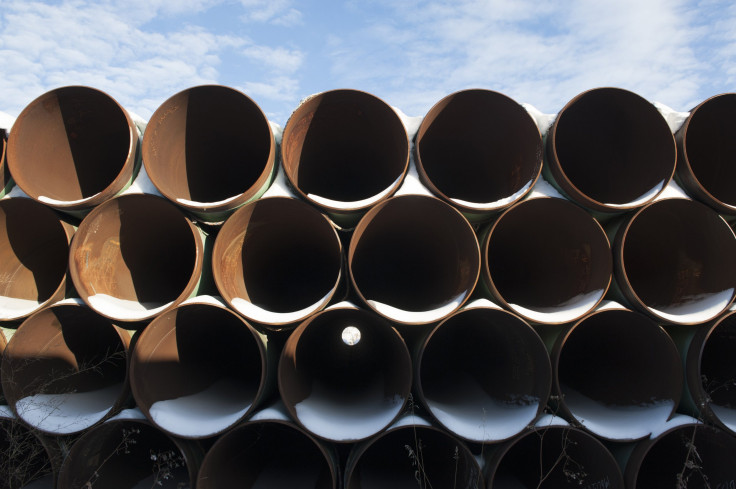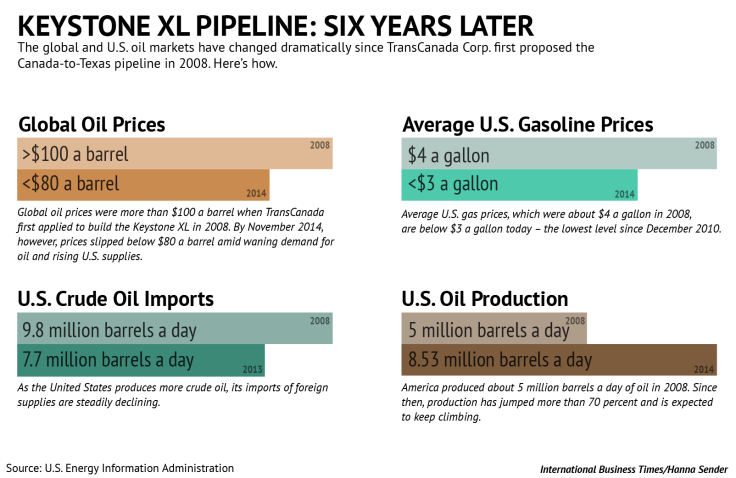Keystone XL Loses Senate Vote, But The Pipeline Matters Less And Less For US Energy Picture

Keystone XL opponents in the U.S. Senate narrowly defeated a bill to approve the oil pipeline. President Barack Obama, who likely would have vetoed the bill, is expected to issue a decision on the project next year.
The Senate vote Tuesday evening, 59-41, was important symbolically (and for Louisiana Sen. Mary Landrieu, a sponsor, perhaps politically). But rising U.S. energy production and falling global oil prices have made the high-profile project less relevant than when it was proposed six years ago. The environmental impact, too, may be less significant than some have argued because the project represents only a fraction of projected gains in global greenhouse gas emissions.
“We’re not as desperate for the pipeline as we once thought,” Michael Webber, deputy director of the Energy Institute at the University of Texas in Austin, said by phone.
The $8 billion Keystone XL pipeline would run nearly 1,200 miles from Canada’s oil sands region to Nebraska, where it would connect with existing lines to the Texas Gulf Coast. The Obama administration has the final say on the 830,000-barrel-a-day project because it crosses international boundaries.
When TransCanada Corp. first proposed the Keystone XL to the U.S. State Department in 2008, global oil prices were more than $100 a barrel, and rising global demand was expected to keep prices high. U.S. crude oil production was flat, around 5 million barrels a day, and American gasoline prices averaged more than $4 a gallon.
The pipeline company and its supporters billed the Keystone XL as a kind of cure-all: By shipping more Canadian crude to U.S. refineries, America could lessen its dependence on expensive oil supplies from the Middle East and Venezuela. The project would create thousands of construction jobs while pushing down gas prices -- giving the U.S. economy a lift.
But in the six years the Obama administration has deliberated on the project, the North American energy picture has shifted dramatically.
The United States no longer needs as much “friendly” Canadian oil to replace imports from its political foes -- it can produce that crude itself, analysts say. American producers are expected to produce 8.53 million barrels a day this year -- about 70 percent more than six years ago -- thanks to advances in drilling technologies like fracking, according to the U.S. Energy Information Administration, a federal statistics agency.
In 2015, U.S. production will hit 9.53 million barrels a day, an amount equal to the capacity of nearly a dozen Keystone XL pipelines. Annual oil imports dropped by about one-fifth from 2008 to 2013, federal data indicate.

America’s oil boom comes as demand is weakening in key economies like China and Europe, which have seen slower-than-expected economic growth. As a result, global crude prices are down, less than $80 a barrel for the first time in four years. That in turn has pushed U.S. gasoline prices to less than $3 a gallon -- the lowest level since December 2010.
“It’s a very different market today from that in which the project was first proposed,” said Lorne Stockman, research director at Oil Change International, an environmental group that opposes the pipeline. “Does the wider U.S. public need this pipeline? I would say not at all.”
Shawn Howard, a spokesman for TransCanada, disagreed. He said even with the surge in U.S. supplies and rising fuel efficiency in cars, the country will still have to import several million barrels of oil per day to meet its demand in the next few decades.
“So the question is: Where would Americans prefer to get the oil they need -- from a country like Canada ... where we share so many interests and values, or places overseas that are often openly hostile to America’s interests and values?” he asked in an email.
For Canadian oil sands developers, the Keystone XL remains critical to business. Pipeline infrastructure is sorely lacking in western Canada, and companies instead are shipping their crude by railroad, a more expensive and potentially riskier alternative. The cost of delivering Canadian oil by rail to the Gulf Coast is about $7 to $8 more expensive per barrel than it is by pipeline, according to industry estimates.
“As the price [of oil] falls, the importance of Keystone as a conduit increases, because it is cheaper than rail and barge to destination markets, and there aren’t a lot of near-term alternatives,” said Kevin Book, a chief analyst at ClearView Energy Partners in Washington.
Gulf Coast refineries also stand to fetch higher profits if the Canada-to-Texas pipeline gets built, he added. Refineries in the region now import about 1.5 million barrels per day of crude oil from Venezuela and Mexico. But with competition from Canadian oil, refineries could likely get the crude at cheaper rates, Book said.
The pipeline’s potential effects on the environment and climate change, however, are harder to determine. Environmental groups have argued building the Keystone XL will spark a boom in Canadian oil sands development, thereby unleashing millions of tons of greenhouse gas emissions that otherwise would’ve stayed trapped in the ground.
Heavy Canadian crude requires more energy to extract and process than conventional oil, and some research suggests the oil itself is more carbon-intensive when burned for consumption. When it spills, it is more difficult to clean up from waterways than lighter blends and is potentially more toxic in the air and water.
The pipeline “would be a step in the wrong direction at a time when we need a rapid shift to clean energy in order to safeguard the climate and our economy,” Eric Pooley, senior vice president of the Environmental Defense Fund, a Washington advocacy group, said in an emailed statement.
Obama has said the pipeline would serve U.S. interests only if the project “does not significantly exacerbate the problem of carbon pollution.” Most experts say it probably would not. The oil that would move through the pipeline would produce annual emissions equal to less than 1 percent of all U.S. greenhouse gas emissions, according to federal estimates.
The president said last week he is still waiting on the State Department to finish its environmental impact analysis to make a final decision, and he cited pending legal action in Nebraska for the continued delay. "My position hasn't changed [on Keystone XL], that this is a process that is supposed to be followed," Obama said at a Friday press conference in Yangon, Myanmar.
© Copyright IBTimes 2024. All rights reserved.





















